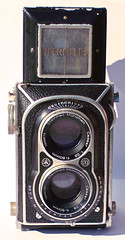Difference between revisions of "Montiflex"
(setup) |
(→Links) |
||
| (10 intermediate revisions by 4 users not shown) | |||
| Line 1: | Line 1: | ||
| − | {{ | + | {{Flickr_image |
| + | |image_source= http://www.flickr.com/photos/mikaeljeney/7073906133/in/pool-camerawiki/ | ||
| + | |image= http://farm6.staticflickr.com/5454/7073906133_7e0419542f_n.jpg | ||
| + | |image_align= right | ||
| + | |image_text= Montiflex TLR | ||
| + | |image_by= Mikael Jeney | ||
| + | |image_rights= with permission | ||
| + | }} | ||
| + | ''Note: a different Montanus Montiflex which lacks the curved bevel above the viewing lens is a name variant of the [[Montanus Delmonta]].'' | ||
| + | |||
The '''Montiflex''' is a 1956 [[TLR]] produced by Potthoff&Co (later [[Montanus|Montanus Kamerafabrik]]) in Solingen, West-Germany. The most unusual characteristic is the focusing magnifier stored in the bottom of the camera. In this same space an extra roll of film can be stored. | The '''Montiflex''' is a 1956 [[TLR]] produced by Potthoff&Co (later [[Montanus|Montanus Kamerafabrik]]) in Solingen, West-Germany. The most unusual characteristic is the focusing magnifier stored in the bottom of the camera. In this same space an extra roll of film can be stored. | ||
| Line 6: | Line 15: | ||
It takes 6×6 pictures on [[120 film]]. Transporting the film does not cock the shutter; it has to be set manually on the taking lens. Lenses accept push-on filters only; there's no filter thred or bayonet. The camera has a flash contact under the taking lens. There is however, no flash shoe present on the body. | It takes 6×6 pictures on [[120 film]]. Transporting the film does not cock the shutter; it has to be set manually on the taking lens. Lenses accept push-on filters only; there's no filter thred or bayonet. The camera has a flash contact under the taking lens. There is however, no flash shoe present on the body. | ||
| − | + | {{br}} | |
== Variations == | == Variations == | ||
| + | {{Flickr_image | ||
| + | |image_source= http://www.flickr.com/photos/thorpehamlet/5555739288/in/pool-camerawiki | ||
| + | |image= http://farm6.static.flickr.com/5053/5555739288_4166e67094_m.jpg | ||
| + | |image_align= right | ||
| + | |image_text= Ultraflex name variant | ||
| + | |image_by= John-Henry Collinson | ||
| + | |image_rights= with permission | ||
| + | }} | ||
* Variations with 80/2.8 Steinheil Cassar exist. | * Variations with 80/2.8 Steinheil Cassar exist. | ||
| − | + | * The '''Ultraflex''' is a name variant | |
| + | * A version was sold by [[Wirgin]] as the '''[[Edixa 6x6]]''' | ||
== Sources == | == Sources == | ||
| − | * | + | * {{McKeown}} 1997/1998 p 328 |
| − | * article in | + | * article in ''Photo Deal'' IV 2003, a German language camera/photographica magazine. |
== Links == | == Links == | ||
| − | * a page dedicated to [http://www.tlr-cameras.com/German/Montanus.html Montanus cameras] and the Montiflex is among them. | + | * a page on [http://www.tlr-cameras.com/ TLR cameras.com] dedicated to [http://www.tlr-cameras.com/German/Montanus.html Montanus cameras] and the Montiflex is among them. |
| + | * [https://www.butkus.org/chinon/montiflex/montiflex.htm Montiflex 6x6 German/English manual] from OrphanCameras.com [https://www.butkus.org/chinon/] | ||
Latest revision as of 22:36, 10 July 2019

|
| Montiflex TLR image by Mikael Jeney (Image rights) |
Note: a different Montanus Montiflex which lacks the curved bevel above the viewing lens is a name variant of the Montanus Delmonta.
The Montiflex is a 1956 TLR produced by Potthoff&Co (later Montanus Kamerafabrik) in Solingen, West-Germany. The most unusual characteristic is the focusing magnifier stored in the bottom of the camera. In this same space an extra roll of film can be stored.
Contents
Specs
Both the Montiflex's taking and viewing lenses are Plascanar 75/3.5 . It has a Prontor SVS shutter (b, 1-1/300s). Unlike other Montanus cameras, the Montiflex has an light value or LV scale on the taking lens. This system automatically changes the aperture when the speeds are changed.
It takes 6×6 pictures on 120 film. Transporting the film does not cock the shutter; it has to be set manually on the taking lens. Lenses accept push-on filters only; there's no filter thred or bayonet. The camera has a flash contact under the taking lens. There is however, no flash shoe present on the body.
Variations

|
| Ultraflex name variant image by John-Henry Collinson (Image rights) |
- Variations with 80/2.8 Steinheil Cassar exist.
- The Ultraflex is a name variant
- A version was sold by Wirgin as the Edixa 6x6
Sources
- McKeown 1997/1998 p 328
- article in Photo Deal IV 2003, a German language camera/photographica magazine.
Links
- a page on TLR cameras.com dedicated to Montanus cameras and the Montiflex is among them.
- Montiflex 6x6 German/English manual from OrphanCameras.com [1]